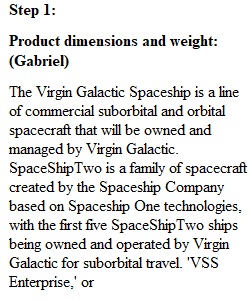


Q Going forward you will now create a marketing strategy for the SBU that your group has selected. Keep in mind the objectives that you have created for this marketing plan. Every one of those objectives should be addressed somewhere within the strategy and align with at least one of the four P’s. In this section your group will discuss all of the relevant product decisions as part of the marketing strategy within this marketing plan. You may choose to develop a new product for the SBU selected, or you may choose to use an existing product. Either way the decisions must be yours. You should not simply list the attributes of an existing product as is. There should be some degree of change depending on the data that you have collected so far regarding the competition, marketing environment, and your target market. Remember to be a specific as possible. Ambiguous responses aren’t of much value here. Also remember that under product decisions you will include things such as: • Product dimensions and weight • Product color design and aesthetics • All relevant product attributes and features • Packaging and the experience in unboxing the product • Warranties • Customer service and training that might be distinct from normal offerings • Anything else that relates to the decisions central to the product itself. Step 1 List each product decision, explain as necessary, and then justify using either information you have discovered in your consumer research, your situational research, or new research that you have discovered using quality sources. Then in parentheses indicate which teammate first came up with the idea. You should have at least one decision per teammate, you are strongly encouraged to come up with more if you think it is worthwhile. Please refer to the example below again using the fictional product of 'widgets': Widget model X-1 Product Dimensions: The X one dimensions of 3” x 4”. This is distinct from the rest of the market which is significantly larger. Our target desires a more compact and easily stored widget (Smith, 2000). By shrinking the dimensions of this product, we will satisfy this specific need. (Joey) Product Materials: our primary research indicated that 80% of our target market prefers brands that minimize waste. Therefore, the model X-1 will be made of 100% recycled aluminum. Aluminum was chosen not only for the availability of recycled material, but it is lighter than the alternative. This is also desired by our target market, we’re 75% indicated they wanted a more portable widget. (Maria)” Rubric Product Decisions Product Decisions Criteria Ratings Pts This criterion is linked to a Learning OutcomeContent 15 pts Meets or Exceeds Expectations The Product development summary clearly identifies how the identified SBU addresses each of the bullet points and shows a solid understanding of the target market. There is obvious inclusion of data collection and identifies competition, the marketing environment, and the target market. Additionally 12 pts Good The summary addresses the points requested and includes information about the marketing environment, competition, and target market, however, it may not align exactly. It is good, but missing some clarity or support. 9 pts Adequate The summary is incomplete. Some of the bullet points are not answered fully or at all. Decisions are not evidence based on data collected. 6 pts Poor The summary is incomplete and shows a lack of understanding of the assignment. 0 pts No Marks The assignment is late or missing. 15 pts This criterion is linked to a Learning OutcomeGrammar and Style 5 pts Full Marks The summary is error free, well formatted, and includes reputable sources. APA 7 format is used. 3 pts Adequate The summary is mostly grammatically correct and follows the style suggested, however supporting sources may be missing and/or APA 7 style is incorrect. 0 pts No Marks Assignment is late or missing. 5 pts Total Points: 20 PreviousNext
View Related Questions